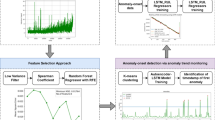Abstract
Fault detection is desirable for increasing machinery availability, reducing consequential damage, and improving operational efficiency. Many of these faulty situations in three-phase induction motors originate from an electrical source. Vibration signal analysis is found to be sensitive to electrical faults. However, conventional methods require detailed information on motor design characteristics and cannot be applied effectively to vibration diagnosis because of their nonadaptability and the random nature of the vibration signals. This paper presents the development of an online electrical fault detection system that uses neural network modeling of induction motor in vibration spectra. The short-time Fourier transform is used to process the quasi-steady vibration signals for continuous spectra so that the neural network model can be trained. The electrical faults are detected from changes in the expectation of modeling errors. Experimental observations show that a robust and automatic electrical fault detection system is produced whose effectiveness is demonstrated while minimizing the triggering of false alarms due to power supply imbalance.










Similar content being viewed by others
References
Singh GK, Al Kazzaz SAS (2003) Induction machine drive condition monitoring and diagnostic research—a survey. Electr Power Syst Res 64:145–158
Liang B, Iwnicki SD, Ball AD (2003) Asymmetrical stator and rotor faulty detection using vibration, phase current and transient speed analysis. Mech Syst Signal Process 17(4):857–869
Thompson WT (2009) On-line motor current signature analysis prevents premature failure of large induction motor drives. Maint Asset Manage 24(3):30–35
Pillay P, Xu Z (1996) Motor current signature analysis. Industry applications conference. Thirty-first IAS annual meeting IAS ‘96, vol 1, pp 587–594
Munoz RA, Nahmias CG (1994) Mechanical vibration of three-phase induction motors fed by nonsinusoidal currents. Proceeding of the international power electronics congress, pp 166–172
Zamarron A, Arjona MA (2010) Detection of stator-winding turn-to-turn faults in induction motors, based on virtual instrumentation. Int J Elect Eng Educ 47(1):63–72
Riley CM, Lin BK, Habetler GT, Schoen RR (1998) A method for sensorless on-line vibration monitoring of induction machines. IEEE Trans Ind Appl 34:1240–1245
Lagan PA (1999) Vibration monitoring. Proceedings of the IEE colloquium on understanding your condition monitoring, pp 1–11
Singh GK, Ahmed SAKS (2004) Vibration signal analysis using wavelet transform for isolation and identification of electrical faults in induction machine. Electr Power Syst Res 68:119–136
Hewlett P (1997) Effective machinery measurement using dynamic signal analyzers. Application note, pp 243-1
Betta G, Liguori C, Paolillo A, Pietrosanto A (2002) A DSP-based FFT-analyzer for the fault diagnosis of rotating machine based on vibration analysis. IEEE Trans Instrum Meas 51(6):1316–1322
Atiya AF, Palos AG (2000) New results on recurrent network training: unifying the algorithms and accelerating convergence. IEEE Trans Neural Netw 13:765–786
Tavner PJ, Penman J (1987) Condition monitoring of electrical machines. Research Studies Press, Letchworth
Kim K, Parlos AG (2003) Reducing the impact of false alarms in induction motor fault diagnosis. ASME J Dyn Syst Meas Control 125:80–95
Kim K, Parlos AG (2002) Model-based fault diagnosis of induction motors using non-stationary signal segmentation. Mech Syst Signal Process 16:223–253
Mohanti N (1987) Signal processing signal filtering detection. Van Nostrand Reinhold, New York
Gao XZ, Ovaska SJ (2000) Motor fault detection using Elman neural network with genetic algorithm-aided training. 2000 IEEE international conference in systems, man, and cybernetics, vol 4, pp 2386–2392
Norgaard M, Ravn O, Poulsen KN, Hansen KL (2000) Neural networks for modeling and control of dynamic systems. Springer, London
Author information
Authors and Affiliations
Corresponding author
Rights and permissions
About this article
Cite this article
Su, H., Chong, K.T. & Ravi Kumar, R. Vibration signal analysis for electrical fault detection of induction machine using neural networks. Neural Comput & Applic 20, 183–194 (2011). https://doi.org/10.1007/s00521-010-0512-3
Received:
Accepted:
Published:
Issue Date:
DOI: https://doi.org/10.1007/s00521-010-0512-3




